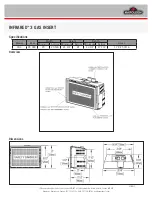
Quick Install Guide
The below steps can be followed to quickly install a CurrentWatch
ECSJ Series switch.
1. Run the wire to be monitored through the aperture.
2. Connect output wiring:
a. Use up to 14 AWG copper wires,
b. Ensure load matches the output shown on the switch label.
3. Adjust the setpoint
a. Choose correct range by positioning the range jumper,
Use the potentiometer to adjust the setpoint.
Switching Delay
Trip response time varies from 2.5 seconds to 0.47 seconds depend-
ing on how much over the set point the current rises. The “reset”
time is about the same.
Setpoint Adjustment
The CurrentWatch ECSJ Series features two setpoint adjustment
mechanisms.
•
First, select the setpoint range with the range jumper.
•
Then, fine tune the setpoint with the four-turn potentiometer (pot).
See the product label for amp ranges and jumper positions.
The four-turn pot is shipped from the factory set fully clock-wise to
the lowest setpoint. Turning the pot counter-clockwise will increase
the setpoint. The pot has a slip-clutch to prevent damage at either
end of its rotation. To determine where the adjustment is, turn the
pot all the way clockwise. This will return it to the minimum setpoint.
Important Setpoint Adjustment Notes
•
Output contacts are solid-state. Check output status by applying
the appropriate voltage and load and then reading the voltage
drop across the contacts. An Ohmmeter set on “continuity” will
give misleading results.
•
It is recommended the setpoint be adjusted to allow for voltage
variations of 10 to 15 percent.
Typical Adjustment Steps
1. Move the jumper to the desired range. Then, turn the pot to the
minimum setpoint (four turns clockwise).
2. Have normal operating current running through the switch. The
output should be tripped since the pot is at its minimum set-
point. For units with an LED, it should be flashing fast (two to
three times per second).
3. Turn the pot counter-clockwise until the unit un-trips. This is indi-
cated by the slow flashing of the LED (once every two to three
seconds), or by changing of the output switch status.
4. Now turn the pot clockwise slowly until the unit trips again. It is
now set at the current level being monitored.
a. To set underload, turn the pot about 1/8 turn further clock-
wise.
b. To set overload, turn the pot about 1/8 turn further counter-
clockwise.
•
For ECSJ421SC models, the LED does not flash. Steady LED-
on indicates contact has been opened.
•
ECSJ407SC, ECSJ401SC and ECSJ421SC all provide a solid on
LED to indicate the output has opened. These models are all
normally closed in the front terminal housing.
Introduction
The CurrentWatch™ ECSJ Series current operated switches
provide the same dependable indication of status offered by the
CurrentWatch ECS Series, but with the added benefit of increased
setpoint accuracy.
A choice of three, jumper selectable input ranges allows the ECSJ
Series to be tailored to an application, providing more precise con-
trol through improved setpoint resolution. Self-powering, isolated
solid-state outputs, 1-6 A, 6-40 A and 40-200 A input ranges, and a
choice of split or solid core enclosures are standard.
Eaton’s current sensor family encompasses a broad range of
products for cost-effective monitoring, status, and predictive main-
tenance. Downtime and costly repairs can be avoided by utilizing
Eaton’s products and technologies in your control systems.
Installation
Considerations for all ECSJ
Series models…
•
Run wire to be
monitored through the
aperture (opening) in
the switch body.
•
These switches can be
located in the same environment as motors,
contactors, heaters, pull-boxes and other electrical enclosures.
•
Mounting can be done in any position or hung on a wire.
•
The high current (15 A) solid state relay in the ECSJ406SC and
ECSJ407SC models generates heat when the switched circuit
rises over three amps. To dissipate this heat, mount the sensor
on a steel or aluminum surface for at least one square foot (930
cm
2
). Thermal transfer compound is recommended.
Considerations for ECSJ split-core models…
•
To open the switch, press the tab inward (toward the body of the
switch) as shown below.
•
After placing the wire in the aperture, press the hinged portion
firmly downward until a click is heard and the tab pops out fully.
•
Keep the contact areas of split-core switches clean at all times.
To open:
Press tab inward
towards hinge
Important:
Keep contact areas clean
2
EATON
www.eaton.com
CurrentWatch™ ECSJ Series Current Sensors
Self-Powered AC Current Sensors with
Jumper Selectable Current Ranges
Instructions Publication
P51919
Effective July 2017






















